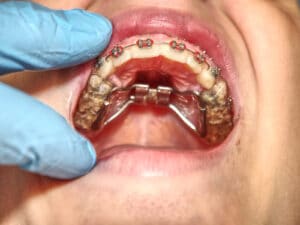A dental mouthguard is an essential tool for protecting your teeth from damage. Whether you wear it for sports, teeth grinding, or as part of a sleep apnea treatment, maintaining it properly is crucial. Without the right care, your mouthguard can quickly accumulate bacteria and odors and even become less effective over time. Proper dental mouthguard maintenance helps extend its life, ensures better hygiene, and keeps it working at its best.
Why Proper Dental Mouthguard Maintenance Is Essential
Taking care of your dental mouthguard is about more than just cleaning it after each use. Regular dental mouthguard maintenance offers several benefits that go beyond hygiene.

- Protects Against Bacteria Build-Up
Just like any oral appliance, your mouthguard can become a breeding ground for bacteria, fungi, and other microorganisms. This can lead to mouth infections or bad breath. Cleaning it regularly prevents harmful bacteria from spreading and helps keep your mouthguard hygienic. - Extends the Life of Your Mouthguard
Mouthguards can be expensive, so it’s in your best interest to make sure they last as long as possible. With regular care, your mouthguard can hold up over time, providing consistent protection. Ignoring maintenance can cause it to wear down faster, reducing its effectiveness. - Prevents Unpleasant Odors
After each use, moisture from your mouth can get trapped inside the mouthguard. If not cleaned and dried properly, it can lead to a buildup of bacteria that causes foul smells. Proper maintenance reduces these odors and ensures that your mouthguard always smells fresh.
Step-by-Step Guide for Effective Dental Mouthguard Maintenance
A good cleaning routine is the foundation of proper dental mouthguard maintenance. Below is a simple guide to help you care for your mouthguard after every use, as well as deeper cleaning methods to implement weekly.
Daily Cleaning Routine: After each use, it’s essential to give your mouthguard a quick cleaning. Here’s how:
- Rinse Immediately: As soon as you take off your mouthguard, rinse it with cold water. This helps remove any saliva, plaque, or food particles that may have accumulated.
- Brush Gently: Use a soft toothbrush and mild soap or non-abrasive toothpaste to gently scrub your mouthguard. Avoid using toothpaste with whitening agents or harsh chemicals, as these can damage the material.
- Rinse Again: Once you’ve brushed it, rinse the mouthguard thoroughly with cold water to remove any soap residue. Then, let it air dry completely before storing it.
Deep Cleaning: Even with daily cleaning, your mouthguard will need a deeper cleanse every week to remove bacteria buildup and ensure freshness.
- Soak in a Cleaning Solution: Once a week, soak your mouthguard for about 10-15 minutes in a mouthguard or denture cleaner. Alternatively, mix a solution of equal parts water and white vinegar for a natural, effective cleaner.
- Alternative—Denture Tablets: If you don’t have a specialized mouthguard cleaner, denture tablets work well too. Drop one tablet into a cup of water and let your mouthguard soak for the recommended time.
- Rinse Thoroughly: After soaking, be sure to rinse your mouthguard well with cold water and allow it to dry completely before storing.
Avoid These Cleaning Practices: Some cleaning habits can damage your mouthguard over time. Here are a few to avoid:
- No Hot Water: Never use hot water, as it can warp the shape of your mouthguard. Always use cold or lukewarm water.
- Avoid Harsh Chemicals: Chemicals like bleach or strong cleaning agents can degrade the material, causing it to crack or lose its effectiveness.
Storing Your Dental Mouthguard Correctly
Proper storage is just as important as cleaning when it comes to dental mouthguard maintenance. Storing your mouthguard correctly can prevent damage, bacterial growth, and help preserve its shape and function.
Use a Case
Storing your mouthguard in a case is essential for keeping it safe. A hard, ventilated case is ideal because it allows air to circulate and prevents moisture from getting trapped, which could lead to bacteria growth. When storing your mouthguard, always ensure the case is clean and dry.
- Tip: Choose a case with ventilation holes for proper airflow. Avoid airtight containers that could trap moisture.
Keep It Dry
After cleaning your mouthguard, let it dry thoroughly before putting it in its case. Moisture left inside the mouthguard or the case can lead to bacterial buildup and unpleasant smells.
- Tip: Never store a damp mouthguard in a case. If you’re storing it while still a bit wet, leave the lid of the case open for a few minutes to ensure it dries completely.
Troubleshooting Common Mouthguard Maintenance Issues
Even with regular cleaning and proper storage, issues can sometimes arise. Here are some common problems you might encounter with your dental mouthguard and how to address them.
Odor Problems
If your mouthguard starts to develop an unpleasant odor, it’s a sign that bacteria or fungus may be building up. Here’s how to fix it:
- Baking Soda Solution: Soak your mouthguard in a solution of water and baking soda for about 30 minutes. Baking soda neutralizes odors and helps eliminate bacteria.
- Frequent Cleaning: Make sure you are rinsing and brushing your mouthguard thoroughly after each use. Avoid letting moisture or food particles sit on the surface for long periods.
- Dry Properly: Always ensure your mouthguard is completely dry before storing it. Moisture can lead to a musty smell.
Discoloration or Staining
Over time, your mouthguard might begin to show stains from food, drinks, or regular use. To remove these:
- Baking Soda and Water Scrub: Mix a small amount of baking soda with water to form a paste. Gently scrub your mouthguard with this paste using a soft brush.
- Soak in Mouthwash: A mild mouthwash solution can help to lighten stains and kill any bacteria. Soak the mouthguard for 10-15 minutes, then rinse thoroughly.
- Specialized Cleaner: If stains persist, consider using a mouthguard cleaner designed to remove discoloration without damaging the material.
Cracks or Damage
Your mouthguard can start to show signs of wear, including cracks or splits, especially if it’s not cleaned and stored properly. If you notice any damage:
- Inspect Regularly: Examine your mouthguard frequently for cracks or thinning spots. Small cracks can grow over time, compromising its effectiveness.
- Replace When Necessary: If the mouthguard becomes cracked or damaged beyond repair, it’s time to replace it. A damaged mouthguard won’t offer proper protection.
Additional Tips for Long-Term Dental Mouthguard Maintenance
To get the most out of your mouthguard, here are a few extra tips that will help keep it in top shape over the long term.
- Avoid Using It for Other Purposes: Mouthguards are designed for specific uses, such as protecting teeth from grinding or injuries. Using it for other purposes, like chewing or biting on it, can damage it. Stick to its intended purpose for the best results.
- Regularly Replace Your Mouthguard: No matter how well you care for your mouthguard, it will eventually wear out. Depending on the frequency of use, it’s a good idea to replace it every 6 to 12 months. Mouthguards used for sports or teeth grinding may need more frequent replacements.
- Use Multiple Mouthguards: If you use your mouthguard for both daytime and nighttime purposes, having a backup can be helpful. This way, you always have a clean, effective mouthguard available while the other is being cleaned or replaced.
When to Replace Your Dental Mouthguard
Even with the best care and maintenance, your mouthguard will eventually need to be replaced. Knowing when it’s time to get a new one is crucial for ensuring your oral protection remains effective. Here are a few signs that indicate it’s time for a replacement:
- Visible Wear and Tear: Over time, your mouthguard may start to show signs of thinning or cracks. If the material starts to break down or if the mouthguard loses its original shape, it can no longer provide the protection it was designed for.
- Persistent Odor Despite Cleaning: If your mouthguard continues to have an unpleasant odor despite regular cleaning and maintenance, it could be a sign that bacteria has deeply infiltrated the material, and it’s no longer safe to use.
- Discomfort or Poor Fit: A mouthguard that has become loose or doesn’t fit properly can be uncomfortable and ineffective. If your mouthguard no longer feels snug or causes irritation, it’s time to replace it. An ill-fitting mouthguard can also lead to damage to your teeth or gums.
- Frequent Use for Over a Year: Even with proper care, mouthguards used frequently, like those worn for teeth grinding or sports, should be replaced every 6 to 12 months. Regular use can cause gradual wear and affect its ability to protect your teeth effectively.
Start Your Journey to a Beautiful, Confident Smile Today
At Dr. Bob Bryan Orthodontics, we’ve been helping patients achieve confident, beautiful smiles for over 50 years. Whether you’re an adult, adolescent, or child, our skilled team in Allentown and Hamburg is committed to providing the highest quality orthodontic care in a comfortable, welcoming environment.
Utilizing advanced treatments like Invisalign and the latest digital technology, we offer personalized care to ensure the best results for your smile. Contact us today to schedule your consultation and take the first step toward the smile you deserve.







